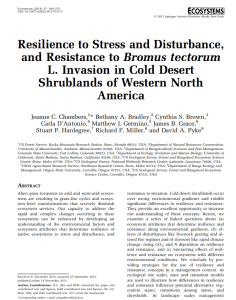Research and Publications
View review.
This review examines the effects of disturbances, such as grazing, and changes in climate on resilience and resistance of cold desert shrublands that span temperature and precipitation gradients across the western United States. It demonstrates how to use information about cold desert resilience and resistance to help manage this ecosystem and describes the benefits of using protection, prevention, restoration, and monitoring strategies to determine priority management areas and appropriate management actions.
View abstracts.
Abstracts of recent papers on fire and fuels management in the West. Prepared by Craig Goodell, Fire Ecologist, USFS Pacific Northwest Region, Portland, OR.
View article.
This study examined stand structure and development of mixed-conifer ecosystems in the south-central Great Basin where pinyon (Pinus monophylla) and juniper (Juniperus osteosperma) are found together with other species, such as ponderosa pine (Pinus ponderosa). Because wildfire regime and land-use changes were not identical between the study sites, and increases of pinyon-juniper populations have occurred in other Great Basin areas at about the same time, climate was the most likely driver. Therefore, pinyon-juniper woodlands, which have recently experienced dramatic episodes of climate-related dieoffs in regions where pinyon is present, have not been negatively impacted by climate in the Great Basin, where the pinyon species is Pinus monophylla.
View article.
In this study, researchers measured particulate sediments transported by wind to assess risks to areas downwind of burned rangelands in SE Idaho. Results indicate that wildfire can convert a relatively stable landscape into one that is a major dust source.
View research brief.
This brief summarizes fire ecology and management issues in California mixed-conifer forests for an audience without a background in fire, including the general public and media.
View article.
This study explored how fire and various other natural events might shape sagebrush ecosystems in eastern Oregon, USA, and whether those events could affect fire rotation. Results suggested other disturbance events were important in shaping all but the most productive sagebrush communities and influenced fire rotation in drier sagebrush communities. Insects and pronghorn browsing may have been as important as fire in shaping sagebrush-steppe landscapes with freezekill and snow mold locally important.
View brief.
In this synthesis of the latest available science, authors challenge the underlying assumptions used to establish most carbon-trading mechanisms, including the notion that lightly managed or unmanaged forests will be more effective at sequestering carbon over long periods than would a combination of managed forests and efficiently produced wood products. They take issue with the measurement systems used to determine trading parameters and find validity in the concerns that many market experts have expressed about additionality and leakage. This report details reasons to look for other solutions to greenhouse gas emission challenges.
View article.
This study highlights that forbs are important for survival of sage grouse chicks, but it can be hard to grow enough forbs under sagebrush canopies dense enough to meet recommended cover levels. Selective thinning and targeted cattle grazing may offer a path to a win/win solution.
View report.
This report synthesizes current information on the effectiveness of post-fire seeding for both soil stabilization and for prevention of the spread of invasive species in rangelands. This information will help federal land managers make more cost-effective decisions on post-fire stabilization and rehabilitation treatments.


